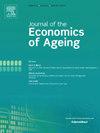Longevity gains and the internal rate of return of PAYG pension plans – Evidence for 17 OECD countries
IF 2
3区 经济学
Q2 DEMOGRAPHY
引用次数: 0
Abstract
We study the impact of the continuous increase of longevity on the internal rate of return from PAYG pension schemes. We use an empirical analysis based on the evidence from 17 developed OECD countries to find that the trend to longer life expectancy leads to an additional return on top of the growth rate of the economy. Depending on the settings of the plan, particularly the retirement age, this extra return varies between 0.10% point and more than 1%-point over time and across countries for cohorts born in the period 1935–1990. The retirement age in most countries during the postwar period lagged the increase in longevity, implying redistribution form younger cohorts to older cohorts. A fair allocation of longevity growth would imply a proportional distribution over the working and retirement periods so that the ratio of working period length and pension period length remains stable over time. We show that an implementation of this fair rule as of the year 1960 would have led to an average reduction in the internal rates of return of 0.4%-point for all countries. The fall in return per country depends on the country-specific divergence of the actual retirement age and the fair rule retirement age. Furthermore, the implementation of the fair rule would have led to more stable contribution rates and to more stable ratios between the retired part and the working part of the population.
现收现付养老金计划的寿命收益和内部收益率——来自17个经合组织国家的证据
我们研究了持续增长的寿命对现收现付养老金计划的内部收益率的影响。我们基于17个发达经合组织国家的证据进行实证分析,发现预期寿命延长的趋势导致经济增长率之外的额外回报。根据该计划的设定,特别是退休年龄的不同,随着时间的推移,对于1935年至1990年期间出生的人群来说,这一额外回报在0.10%到1%以上之间变化。在战后时期,大多数国家的退休年龄落后于寿命的增长,这意味着从年轻人到老年人的再分配。寿命增长的公平分配意味着在工作和退休期间按比例分配,以便工作期限和养恤金期限的比率随时间保持稳定。我们表明,在1960年实施这一公平规则将导致所有国家的内部回报率平均下降0.4%。每个国家回报的下降取决于各国实际退休年龄和公平退休年龄的具体差异。此外,执行公平规则将导致更稳定的缴款率和退休人口与工作人口之间更稳定的比率。
本文章由计算机程序翻译,如有差异,请以英文原文为准。
求助全文
约1分钟内获得全文
求助全文
来源期刊

Journal of the Economics of Ageing
Multiple-
CiteScore
4.10
自引率
4.50%
发文量
46
审稿时长
49 days
期刊介绍:
The Journal of the Economics of Ageing (JEoA) is an international academic journal that publishes original theoretical and empirical research dealing with the interaction between demographic change and the economy. JEoA encompasses both microeconomic and macroeconomic perspectives and offers a platform for the discussion of topics including labour, health, and family economics, social security, income distribution, social mobility, immigration, productivity, structural change, economic growth and development. JEoA also solicits papers that have a policy focus.
 求助内容:
求助内容: 应助结果提醒方式:
应助结果提醒方式:


